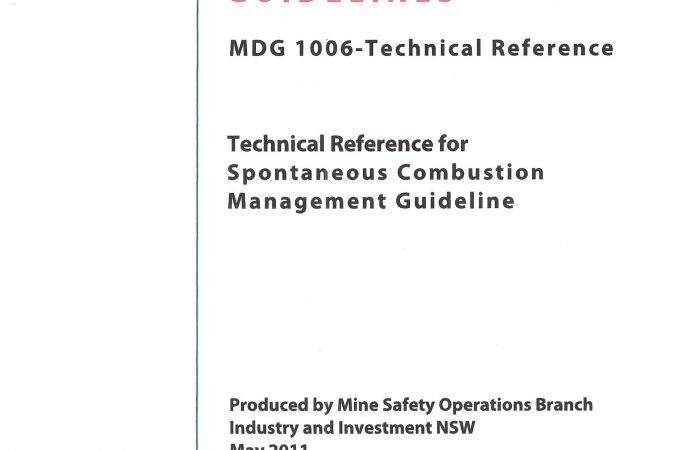
NSW has MDG 1006 Spontaneous Combustion Management. Queensland does not. North Goonyella seems to either fail or exceed all the critical parameters whichever way you choose to look at it
I have cut a few Sections from the 112 page MDG 1006 Spontaneous Combustion Management
NSW MDG are not acknowledged under the Qld Coal Mining Safety and Health Act 1999.
Please read the following and think about how they apply at North Goonyella.
North Goonyella seems to either fail or exceed all the critical parameters whichever way you choose to look at it
This applies equally to both North Goonyella Management or Inspectors
https://www.resourcesregulator.nsw.gov.au/__data/assets/pdf_file/0006/419514/MDG-1006-TR-spontaneous-combustion-management.pdf
6.3.1 Physical Inspection
The observation of physical signs is an important method of detection. Physical signs are:
- Rise in temperature
- Sweating (approx. 100C)
- Smell (approx. 110C)
- Haze Smoke (approx. 300C)
In some coal seams, very little CO is given off before the heating can be detected by smell or
other physical signs. (Greta seam) In other coal seams, gaseous indicators may provide the best
early warning. (Liddell seam)
Small quantities of CO may be missed (location and placement of sampling points etc.) or be
considered erroneous because the readings were not repeated on a regular basis. Even a fleeting
smell is distinctive to an experienced and trained person.
The key factor in the detection of spontaneous combustion is a change from normal conditions.
Changes can be in airflow and direction, smell, temperature, gas levels etc. Any change should
be fully investigated
7.5 RAPID SEALING
Provision for rapid sealing of parts of the mine is an important element of a spontaneous combustion management plan.
During the withdrawal process there is the possibility of isolating the part of the mine affected by rapid sealing such as closing doors etc. if this contingency has been foreseen and effective provisions put in place.
If not, any actions taken to control or ameliorate the effects of the heating after withdrawal of people will have to be developed and designed and carried out remotely. This may be difficult and time consuming.
If there is surface access to the area above the heating site, the option of sealing the panel or part of the mine is available by using fly ash or other roadway filler. This also allows water or an inert gas to be introduced into the affected area from the surface by means of the Mineshield (nitrogen), Thomlinson boiler, Floxal unit or other means.
When making provision for sealing mine entries, the risk of explosion needs to be considered.
Sealing the entries may have to be done without placing personnel in front of the entries where they may be harmed by an explosion.
4.1 HISTORY
The history of spontaneous combustion events at a mine, adjacent underground and open cut
mines and the same coal measures in other areas, is invaluable in providing guidance on the
propensity for heating, location of heatings and behavior of the coal (gas evolution) as it self-heats.
There may be considerable information where the coal seam has been mined extensively.
This may indicate a high or low propensity for spontaneous combustion. Testing coal for propensity
for spontaneous combustion is useful although there are limitations in its validity. Information
from operating experience in the seam is of great value.
4.4.15 Face Finish Line –
This is controlled by rapid salvage of face equipment and by design of adequate final barrier pillars.
The risk may arise if face recovery is delayed by equipment failures, industrial action or mining conditions.
4.4.17 Ventilation Pressure Difference
A pressure difference between two areas in a mine will cause air to flow from the higher to the lower pressure area. The amount of air that flows along each path depends upon the resistance to flow. This can result in unplanned ventilation flows and air leakage.
High ventilation quantities and pressure differential may result in air leakage into or from a sealed area or through or around pillars which will increase the risk of spontaneous combustion.
A good example of this is the pressure difference between an active longwall face and the
ventilated gate road alongside the goaf of the active longwall, especially if it is a return
4.4.19 Reduced Extraction Rate &/or Unplanned Disruption
Continuance of a rapid rate of retreat ensuring that coal in the goaf is sealed or immersed in an inert atmosphere before accelerated oxidation occurs, is an effective means of preventing spontaneous combustion in a goaf.
An unplanned disruption to mining, or significantly reduced extraction rate could result in an increased risk of spontaneous combustion. These events can occur due to geological &
geotechnical factors, industrial action and slowness in moving a longwall after panel completion.
Means to increase the rate of retreat include:
Reschedule planned maintenance
Operate weekend shifts that may not be planned for production
4.4.20 Extracted Areas
Goaves are a potential source of heating if not sealed. Ventilation may be such that the oxygen supply is adequate to promote oxidation but the cooling effect is inadequate to prevent heating.
Where goaves are sealed, there may be a risk of a heating where there is leakage of air through or
around seals, and a high pressure differential exists. There will be no effect in the deep-seated
regions but areas near sealing sites may be continually supplied with oxygen from barometric
pressure fluctuations.
4.4.21 Barometric Variations
Flow into sealed areas results not only from differences in the mine ventilating pressure, but also
from the large volumes of such areas, affected by barometric changes creating inflow and
outflows.
Barometric changes may range from about 960 to 1040 millibars and rapid changes in
barometric pressure can occur as a result of storm activity. This represents a change in absolute pressure of 8Kpa, which is significantly greater that the pressure differential at which mine fans typically operate.
The rate of change has the greatest influence. This pressure differential acts on the seals in a
mine. Well-constructed seals and surrounds can act to restrict the volume flowing and retard the
changes in sealed areas by reducing the effects of peaks and troughs in the barometric pressure
fluctuation.
4.4.23 Boreholes & Wells
Unsealed boreholes or wells may provide a conduit for air to flow from the surface into a goaf area, or allow the atmosphere in the goaf to flow to the surface.
Boreholes placed in areas affected by subsidence pose a risk, even if not drilled all the way to the coal seam.
4.4.24 Accessibility of Roadways Adjacent to Goaf for Inspection
If the roadway adjacent to the stopping or seal becomes inaccessible there is the risk of a
damaged and leaking stopping and the non-detection of a heating. If a stopping or seal is to be
relied upon to contain and inertise a goaf, then its integrity should be able to be confirmed by
periodic inspection.
4.4.25 Integrity & Effectiveness of Monitoring System
Detection of increasing levels of oxygen in goaves and early signs of heating will rely upon effective monitoring and inspection systems. The location and number of monitoring points is critical to the effectiveness of the system.
If the monitoring and inspection system is not properly designed, implemented and maintained, there is a risk that spontaneous combustion will not be detected until a serious problem develops.
MDG 1006 Spontaneous Combustion Management – Technical Reference Page 26 of 112
Sample turnaround time is a factor. If the information is not provided promptly, decisions and corrective action may be delayed.
4.4.26 Reporting & Tracking of Information
Recording of results of inspections and historical data is important as is the review and action as a response to this information. Information recorded should be specific in terms of the time, location, quantities etc. if it is to be of value.
Inspections missed, or inadequate interpretation of information is a hazard.
Integral to a comprehensive and effective reporting system is an audit & review process to provide checks and balances in the mine’s stated controls for spontaneous combustion.
4.4.28 Surface access
Access may be required to surface areas of the mine for the purpose of monitoring, or remedial action in the event of a heating.
This needs to be considered for an effective and prompt response to an incident.

